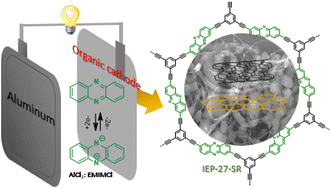A phenazine-based conjugated microporous polymer as a high performing cathode for aluminium–organic batteries†
Abstract
One of the possible solutions to circumvent the sluggish kinetics, low capacity, and poor integrity of inorganic cathodes commonly used in rechargeable aluminium batteries (RABs) is the use of redox-active polymers as cathodes. They are not only sustainable materials characterised by their structure tunability, but also exhibit a unique ion coordination redox mechanism that makes them versatile ion hosts suitable for voluminous aluminium cation complexes, as demonstrated by the poly(quinoyl) family. Recently, phenazine-based compounds have been found to have high capacity, reversibility and fast redox kinetics in aqueous electrolytes because of the presence of a C![[double bond, length as m-dash]](https://www.rsc.org/images/entities/char_e001.gif) N double bond. Here, we present one of the first examples of a phenazine-based hybrid microporous polymer, referred to as IEP-27-SR, utilized as an organic cathode in an aluminium battery with an AlCl3/EMIMCl ionic liquid electrolyte. The preliminary redox and charge storage mechanism of IEP-27-SR was confirmed by ex situ ATR-IR and EDS analyses. The introduction of phenazine active units in a robust microporous framework resulted in a remarkable rate capability (specific capacity of 116 mA h g−1 at 0.5C with 77% capacity retention at 10C) and notable cycling stability, maintaining 75% of its initial capacity after 3440 charge–discharge cycles at 1C (127 days of continuous cycling). This superior performance compared to reported Al//n-type organic cathode RABs is attributed to the stable 3D porous microstructure and the presence of micro/mesoporosity in IEP-27-SR, which facilitates electrolyte permeability and improves kinetics.
N double bond. Here, we present one of the first examples of a phenazine-based hybrid microporous polymer, referred to as IEP-27-SR, utilized as an organic cathode in an aluminium battery with an AlCl3/EMIMCl ionic liquid electrolyte. The preliminary redox and charge storage mechanism of IEP-27-SR was confirmed by ex situ ATR-IR and EDS analyses. The introduction of phenazine active units in a robust microporous framework resulted in a remarkable rate capability (specific capacity of 116 mA h g−1 at 0.5C with 77% capacity retention at 10C) and notable cycling stability, maintaining 75% of its initial capacity after 3440 charge–discharge cycles at 1C (127 days of continuous cycling). This superior performance compared to reported Al//n-type organic cathode RABs is attributed to the stable 3D porous microstructure and the presence of micro/mesoporosity in IEP-27-SR, which facilitates electrolyte permeability and improves kinetics.

- This article is part of the themed collection: Challenges and prospects in organic photonics and electronics


 Please wait while we load your content...
Please wait while we load your content...